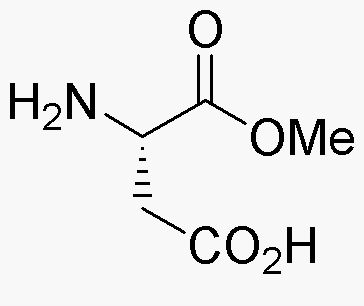L-Aspartic acid a-methyl ester is widely utilized in research focused on:
- Pharmaceutical Development: This compound serves as a key intermediate in synthesizing various pharmaceuticals, particularly those targeting neurological disorders, enhancing drug efficacy and specificity.
- Biotechnology: It is used in the production of peptide-based drugs and biopolymers, providing a versatile building block for innovative therapeutic solutions.
- Amino Acid Supplementation: Commonly found in dietary supplements, it supports muscle recovery and energy production, making it popular among athletes and fitness enthusiasts.
- Food Industry: Employed as a flavor enhancer and nutritional additive, it contributes to the taste and nutritional profile of various food products.
- Research Applications: Utilized in biochemical studies to explore metabolic pathways and enzyme functions, aiding researchers in understanding cellular processes and developing new treatments.
General Information
Properties
Safety and Regulations
Applications
L-Aspartic acid a-methyl ester is widely utilized in research focused on:
- Pharmaceutical Development: This compound serves as a key intermediate in synthesizing various pharmaceuticals, particularly those targeting neurological disorders, enhancing drug efficacy and specificity.
- Biotechnology: It is used in the production of peptide-based drugs and biopolymers, providing a versatile building block for innovative therapeutic solutions.
- Amino Acid Supplementation: Commonly found in dietary supplements, it supports muscle recovery and energy production, making it popular among athletes and fitness enthusiasts.
- Food Industry: Employed as a flavor enhancer and nutritional additive, it contributes to the taste and nutritional profile of various food products.
- Research Applications: Utilized in biochemical studies to explore metabolic pathways and enzyme functions, aiding researchers in understanding cellular processes and developing new treatments.
Documents
Safety Data Sheets (SDS)
The SDS provides comprehensive safety information on handling, storage, and disposal of the product.
Product Specification (PS)
The PS provides a comprehensive breakdown of the product’s properties, including chemical composition, physical state, purity, and storage requirements. It also details acceptable quality ranges and the product's intended applications.
Certificates of Analysis (COA)
Search for Certificates of Analysis (COA) by entering the products Lot Number. Lot and Batch Numbers can be found on a product’s label following the words ‘Lot’ or ‘Batch’.
Numéro de catalogue
Numéro de lot/série
Certificates Of Origin (COO)
This COO confirms the country where the product was manufactured, and also details the materials and components used in it and whether it is derived from natural, synthetic, or other specific sources. This certificate may be required for customs, trade, and regulatory compliance.
Numéro de catalogue
Numéro de lot/série
Safety Data Sheets (SDS)
The SDS provides comprehensive safety information on handling, storage, and disposal of the product.
DownloadProduct Specification (PS)
The PS provides a comprehensive breakdown of the product’s properties, including chemical composition, physical state, purity, and storage requirements. It also details acceptable quality ranges and the product's intended applications.
DownloadCertificates of Analysis (COA)
Search for Certificates of Analysis (COA) by entering the products Lot Number. Lot and Batch Numbers can be found on a product’s label following the words ‘Lot’ or ‘Batch’.
Numéro de catalogue
Numéro de lot/série
Certificates Of Origin (COO)
This COO confirms the country where the product was manufactured, and also details the materials and components used in it and whether it is derived from natural, synthetic, or other specific sources. This certificate may be required for customs, trade, and regulatory compliance.


